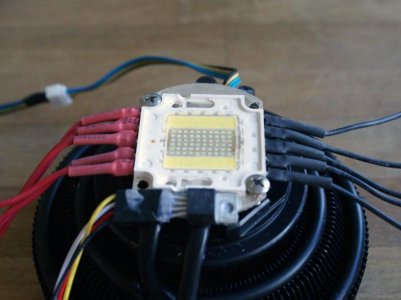Why?
I can't recall any definitive and credible academic studies concluding reef tank corals (very broad group), anemones and T. clams require the amount of blue light accepted as the norm in the hobby. Imo, it does more for the reefer in terms of bringing out colors and pop which pleases them more then the corals. Great marketing concept too. Exception being if the corals are and were collected in deepwater. .
For starters les's look at what PAR is. It is the measurement of all light emitted in wave lenghts between 400 and 700 nm. Now lets us look at what Coral need they need for photosynthesis mainly the light emited between 400 nm and 520 nm, with a much less secondary need on some corals between 620 and 680nm. So we can say that the range of PAr lighting is over 300 nm with a 180 nm range being utilized and a 120 nm range not being utilized by the coral.
But if we look at most lighting sources in our home they are centered on providing the brightest lighting for our visual pleasure. For tht reason they look at our eye sensativity being the highest in the 500 to 600 nm range where they emit the most light. This not used by coral but provides better viewing to us for the reflective colors of coral. So with some light sources rather than 40% of the light not being utilized we more to levels of more than 50% more.
Personal communication with Dr Mac re: maricultured corals, he said they are grown in knee deep water and he considers deepwater corals those grown and or collected in ~20'. Just read his sites description, and ask yourself how much blue light those corals are receiving (i highly doubt anywhere near whats being marketed to reefers)?
http://www.liveaquaria.com/diversden/CatDisplay.cfm?c=2733+6
"Maricultured Corals are propagated overseas and grown out in shallow protected lagoons or in outdoor raceways using natural sunlight and ocean water."
.
I have no doubt that corals can survive under strict full spectrumed light. But if we are trying to be economical with outh our lighting then you can compare what the actural corals need and get from a 1000 Watts of Full spectrum lighting to be almost equal to what they can get from 600 watts of spectrum selected lighting. If your tuning for a specific coral or group of coras this can even be lowered to the 300 or 400 watt range.
Anemone and T. clam keepers have long acknowledged those animals usually are shallow water and benefit more from a strong daylight spectrum then the blue light norm of the hobby. .
My comments are based more on corals than anything else. However I do know of an individdual that has grown some fantastic Clams. He got them roughly 4 years ago in the 2" size rang and now they are between 8" and 12" with fantastic colors. His lighting consists of three 250 Watt 20,000K MH's that he runs 5 hours a day, and 300 watts of Royal Blue LED's that he runs for 12 hours per day. He atributes the growth and color more to his feeding than the lights though.
I personally am maintaining a 40gallon breeder of SPS corals under a 2x2 mix of four hanging Daylight 5000 K, PAR38 spots.
Two are a Multichip overdriven to 23watts which i got at Lowes, Utilitech Pro (Feit), 23watt 1400lumens 5000 K 83 CRI. The other two spots sourced from Home Depot each consist of ten individual chips, Philips 19.5watt 1300lumens 5000 K 80 CRI. I found the Philips to be more a pinkish blue light and the Utilitech a greenish daylight. The mix works well and the tank does not appear yellow. .
I'm not sure if I'm calulating this correctly but it sounds to me ike you have roughly 85 Watts of lighting on that 40 Breeder. From your description I would say that those chips are probably not true 5,000K if you take reference to a true Kelvin color chart and your description of the lighting.
I have several 40 breeders going. The best reslts I have gotten to date is from running 8 Watts of Neutral Whites (4,500K) 8 Watts of True Blue (470 nm) 8 Watts of near UV 430 nm and 24 Watts of Royal Blue (454 nm). This is a total of 52 watts watts measured at the outlet and I also have fantastic growth and color.
But this sort of proves my point your running 80 watts and getting the same effect as I am runnning at 52 watts. That mean there is a 35% difference in the effeciency of the lighting as far as coral growth goes.
Btw, i played around with daylight spectrum lamps for years, we didn't have many options in the late eighties.
LED's did not exist in the 80's. But I worked in the industry on florescent tubes back then. The offerening have not changed that much but the availabbility has changed. They basicly retailed only the high demand bulbs back then and the specialty bulbs were only prodiced as special order runs. Interstingly it was not uncommon to runthe specialty bulbs and they would end up with several different stampings of various vendors like Corallife, and Penplex both claiming the same bulb was something else.



